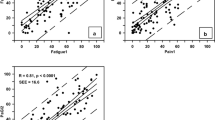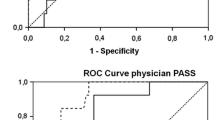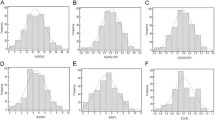Abstract
The Bath Ankylosing Spondylitis Disease Activity Index (BASDAI), the Bath Ankylosing Spondylitis Function Index (BASFI) and the Bath Ankylosing Spondylitis Global Score (BAS-G) (ranges 0–10) have gained widespread in use as self-reported measures of disease activity, functional impairment and overall well-being in patients with ankylosing spondylitis and other spondyloarthropathies (SpA). In Denmark, BASDAI, BASFI and BAS-G are systematically used to monitor treatment response in patients treated with tumour necrosis factor (TNF) inhibitors. The purpose of the present study was to examine the reproducibility of the indices in anti-TNF-treated SpA patients already familiar with the use of the indices. Testing was performed twice on two different days (median interval 7 days, range 4–10 days) under standardised conditions in 26 out-clinic patients (median age 39 years, range 22–56 years). Limits of agreement were calculated as the 95% likely range for the difference between paired scores. Test–retest results were significantly intercorrelated with r s = 0.90 for BASDAI, 0.92 for BASFI and 0.74 for BAS-G. Limits of agreement for BASDAI, BASFI and BAS-G were ±1.8, ±1.4 and ±3.2, respectively. Reproducibility as expressed as the mean of individual standard deviations was significantly poorer for BAS-G than for BASDAI and BASFI (p < 0.01). Internal consistency reliability and construct validity of BASDAI and BASFI were acceptable. In conclusion, in a sample of anti-TNF-treated patients experienced with the use of BASDAI, BASFI and BAS-G, random measurement errors of the scores were not negligible. The finding should be considered when monitoring anti-TNF treatment in daily clinical practice.
Similar content being viewed by others
References
Zochling J, Braun J (2007) Assessments in ankylosing spondylitis. Best Pract Res Clin Rheumatol 21:699–712
Ward MM (1998) Quality of life in patients with ankylosing spondylitis. Rheum Dis Clin North Am 24:815–827
Garrett S, Jenkinson T, Keenedy G et al (1994) A new approach to evaluate to defining disease status in ankylosing spondylitis: the Bath Ankylosing Spondylitis Disease Activity Index. J Rheumatol 1:2286–2291
Calin A, Garrett S, Whitelock H et al (1994) A new approach to defining functional ability in ankylosing spondylitis: the development of the Bath Ankylosing Spondylitis Functional Index. J Rheumatol 21:2281–2285
Jones SD, Steiner A, Garrett SL et al (1996) The Bath ankylosing spondylitis patient global score (BAS-G). Br J Rheumatol 35:66–71
Zochling J, van der Heijde D, Burgos-Vargas R et al (2006) ASAS/EULAR recommendations for the management of ankylosing spondylitis. Ann Rheum Dis 65:442–452
Sidiropoulos PI, Hatemi G, Song IH et al (2008) Evidence-based recommendations for the management of ankylosing spondylitis: systematic literature search of the 3E Initiative in Rheumatology involving a broad panel of experts and practising rheumatologists. Rheumatol (Oxf) 47:355–361
Hetland ML (2005) DANBIO: a nationwide registry of biological therapies in Denmark. Clin Exp Rheumatol 23(5 suppl 39):S205–S207
Altman DG, Bland JM (1986) Statistical methods for assessing agreement between two methods of clinical measurement. Lancet 1:307–310
Cronstedt H, Waldner A, Stenström CH (1999) The Swedish version of the Bath ankylosing spondylitis functional index. Reliability and validity. Scand J Rheumatol Suppl 111:1–9
Waldner A, Cronstedt H, Stenström CH (1999) The Swedish version of the Bath Ankylosing Spondylitis Disease Activity Index. Reliability and validity. Scand J Rheumatol Suppl 111:10-
Pedersen OB, Hansen GO, Svendsen AJ et al (2007) Adaptation of the Bath measures on disease activity and function in ankylosing spondylitis into Danish. Scand J Rheumatol 36:22–27
Udrea G, Ciobanu C, Mihai C et al (2004) Evaluation of the Romanian version of the Bath Ankylosing Spondylitis Functional Index (BASFI) in patients with spondyloarthropathies. Rom J Intern Med 42:199–209
Accoc Y, Karatepe AG, Akar S et al (2005) A Turkish version of the Bath Ankylosing Spondylitis Disease Activity Index: reliability and validity. Rheumatol Int 25:280–284
Karatepe AG, Akkoc Y, Akar S et al (2005) The Turkish versions of the Bath Ankylosing Spondylitis and Dougados Functional Indices: reliability and validity. Rheumatol Int 25:612–618
Chatzitheodorou D, Kabitsis C, Papadopoulos NG et al (2007) Evaluation of the Greek version of the Bath Ankylosing Spondylitis Functional Index: reliability, validity, and factor analysis. Clin Exp Rheumatol 25:571–576
El Miedany Y, Youssef S, Mehenna A (2008) Defining disease status in ankylosing spondylitis: validation and cross-cultural adaptation of the Arabic Bath Ankylosing Functional Index (BASFI), the Bath Ankylosing Spondylitis Disease Activity Index (BASDAI), and the Bath Ankylosing Spondylitis Global Score (BASG). Clin Rheumatol 27:605–612
Cardiel MH, Londono JD, Gutierrez E et al (2003) Translation, cross-cultural adaptation, and validation of the Bath Ankylosing Spondylitis Functional Index (BASFI), the Bath Ankylosing Spondylitis Disease activity Index (BASDAI) and the Dougados Functional Index (DFI) in a Spanish speaking population with spondyloarthropathies. Clin Exp Rheumatol 21:451–458
Heikkila S, Viitanen JV, Kautianen H et al (2000) Evaluation of the Finnish versions of the functional indices BASFI and DFI in spondyloarthropathy. Clin Rheumatol 19:464–469
Claudepierre P, Sibilia J, Goupille P et al (1997) Evaluation of a French version of the Bath Ankylosing Spondylitis Disease Activity Index in patients with spondyloarthropathy. J Rheumatol 24:1954–1958
Ozer HT, Sarpel T, Gulek B (2005) The Turkish version of the Bath Ankylosing Spondylitis Functional Index: reliability and validity. Clin Rheumatol 24:123–128
Wei JC, Wong RH, Huang JH et al (2007) Evaluation of internal consistency and re-test reliability of Bath ankylosing spondylitis indices in a large cohort of adult and juvenile spondylitis patients in Taiwan. Clin Rheumatol 26:1685–1691
Dougados M, van der Linden S, Juhlin R et al (1991) The European Spondylarthropathy Study Group preliminary criteria for the classification of spondylarthropathy. Arthritis Rheum 34:1218–1227
Van der Linden S, Valkenburg HA, Cats A (1984) Evaluation of diagnostic criteria for ankylosing spondylitis: a proposal for modification of the New York criteria. Arthritis Rheum 27:361–368
Jenkinson TR, Mallorie PA, Whitelock HC (1994) Defining spinal mobility in ankylosing spondylitis (AS): the Bath AS Metrology Index. J Rheumatol 21:694–698
Madsen OR, Hansen LB, Rytter A, Suetta C, Egsmose C (2009) The Bath metrology index as assessed by a trained and an untrained rater in patients with spondylarthropathy: a study of intra- and inter-rater agreements. Clin Rheumatol 28:35–40
Bland JM, Altman DG (1996) Statistics notes: measurement error. BMJ 313:714
Glüer CC, Blake G, Lu Y (1995) Accurate assessment of precision errors: how to measure the reproducibility of bone densitometry techniques. Osteoporosis Int 5:262–270
Bland JM, Altman DG (1996) Statistics notes: measurement error and correlation coefficients. BMJ 313:41–42
van der Heijde D, Dijkmans B, Geusens P et al (2005) Efficacy and safety of infliximab in patients with ankylosing spondylitis: results of a randomized, placebo-controlled trial (ASSERT). Arthritis Rheum 52:582–591
van der Heijde D, Schiff MH, Sieper J et al (2009) Adalimumab effectiveness for the treatment of ankylosing spondylitis is maintained for up to 2 years: long-term results from the ATLAS trial. Ann Rheum Dis 68:922–929
Disclosures
None.
Author information
Authors and Affiliations
Corresponding author
Rights and permissions
About this article
Cite this article
Madsen, O.R., Rytter, A., Hansen, L.B. et al. Reproducibility of the Bath Ankylosing Spondylitis Indices of disease activity (BASDAI), functional status (BASFI) and overall well-being (BAS-G) in anti-tumour necrosis factor-treated spondyloarthropathy patients. Clin Rheumatol 29, 849–854 (2010). https://doi.org/10.1007/s10067-010-1407-5
Received:
Revised:
Accepted:
Published:
Issue Date:
DOI: https://doi.org/10.1007/s10067-010-1407-5




